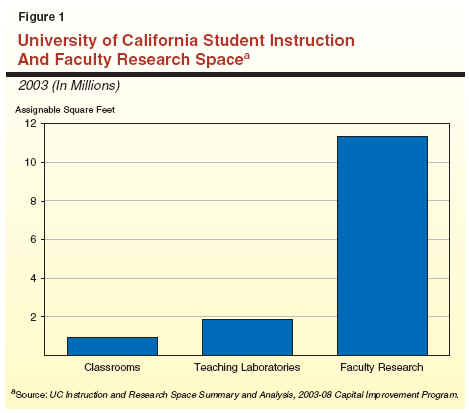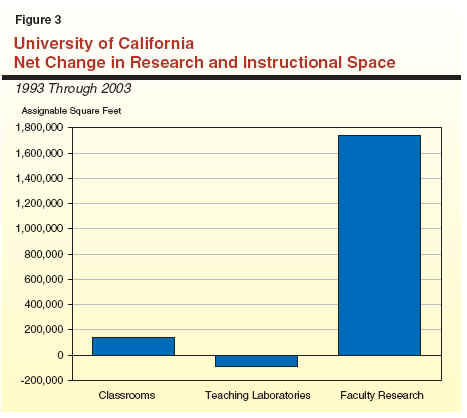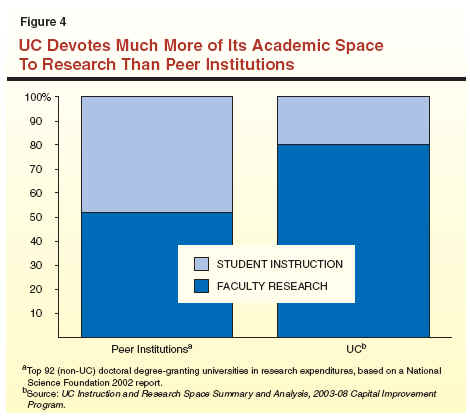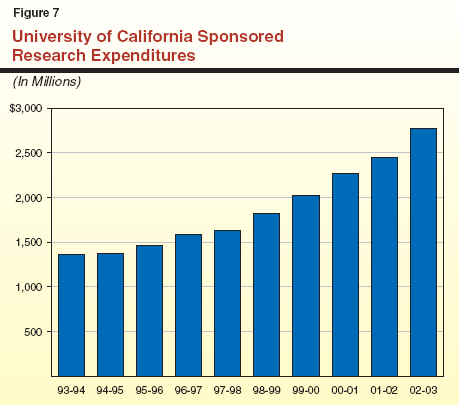
June 23, 2004
The University of California (UC) receives funding from the federal government, the state, and for- and not-for-profit institutions and companies to undertake various research activities. In addition to funding the direct cost of the research, UC charges research sponsors for facilities and other overhead costs. In this report we examine faculty research facilities at UC and how their construction is funded. We also look at the research overhead revenue UC receives and how it is used. Finally, we raise issues as to whether UC is maximizing its use of overhead revenue to fund faculty research facilities and offer recommendations as to how the state can reduce General Fund costs in this area.
The University of California (UC) is designated as the state's primary research institution. The research UC faculty undertakes satisfies academic and societal needs—and it generates substantial revenue for UC. The revenue comes primarily from sponsored research projects. The UC receives sponsored research funding from the federal government, the state, and for- and not-for-profit institutions and companies to undertake research that explores technologies and other areas of interest to the sponsor. In 2002-03, UC expended about $2.8 billion related to sponsored research and scholarly activity. In addition to this amount are charges UC applies to sponsored grants and contracts for facilities and administration overhead costs.
To house faculty research activities, the state has funded the construction of research laboratories and other research facilities. The UC currently has about 11.6 million assignable square feet (asf) of faculty research space at its eight general campuses. Almost 1.4 million asf of UC's faculty research space has been funded by the state just since 1998—at a cost of over $800 million. The state has also appropriated an additional $300 million to construct four research "institutes for science and innovation" that are currently under development.
In this report we examine faculty research facilities at UC and how their construction is funded. We also look at the research overhead revenue UC receives and how it is used. Finally, we raise issues as to whether UC is maximizing its use of overhead revenue to fund faculty research facilities and offer recommendations as to how the state can reduce General Fund costs in this area.
The UC has about 14.5 million asf of academic space at its eight general campuses. Academic space is of two types—instructional space (classrooms and teaching laboratories) and faculty research space. As Figure 1 shows, UC has 2.9 million asf of instructional space—1 million asf of classrooms and 1.9 million asf of teaching laboratories. By comparison, it has 11.6 million asf of faculty research space. (This does not include faculty research space at its five medical schools.)

The magnitude of UC's faculty research space is more than all the office space in downtown San Diego. Figure 2 shows how the research space is distributed among the campuses.
|
Figure 2
|
|
|
Assignable Square Feet |
|
|
Campus |
|
|
Berkeley |
2,738 |
|
Davis |
1,607 |
|
Irvine |
1,060 |
|
Los Angeles |
1,957 |
|
Riverside |
727 |
|
San Diego |
1,828 |
|
Santa Barbara |
1,017 |
|
Santa Cruz |
698 |
|
Total |
11,632 |
|
|
|
|
Source:
UC Instruction and Research Space Summary and Analysis, 2003-08
Capital Improvement Program. Does not include faculty research space
at the five UC medical schools. |
|
In the last ten years the amount of faculty research space at the eight general campuses increased by over 1.7 million asf (see Figure 3). By comparison, the amount of instructional space increased by only about 91,000 asf—classroom space increased by about 169,000 asf and teaching laboratories decreased by 78,000 asf.

As described above, UC devotes about four times as much space to faculty research as direct student instruction. To evaluate whether this is an appropriate amount of research space, we compared UC to its peer institutions nationwide. We examined the amount of faculty research space UC has compared to comparable institutions. We have used as UC's peer group the top 92 non-UC doctoral degree-granting universities in research expenditures, as reported by the National Science Foundation. As Figure 4 indicates, UC's peer universities throughout the country have about half of their academic space devoted to faculty research. By comparison, about 80 percent of UC's academic space is for faculty research.

Faculty research facilities are much more expensive to construct than classrooms and teaching laboratories for student instruction. In the last five years the state funded construction of 27 UC buildings that contained between 50 percent and 100 percent faculty research space. The average cost to construct these buildings was almost $600 per asf. This compares to about $299 per asf for classroom and $466 per asf for teaching laboratory buildings. (These figures are based on 2003-04 construction cost guidelines used by California State University; UC does not use construction cost guidelines.)
The UC faculty research facilities are also expensive when compared to the cost of constructing comparable research buildings nationwide. We examined the construction costs for over 400 research buildings at public and private universities, institutions, agencies, and companies nationwide and found that—after adjusting for inflation and geographical differences in construction costs—half of them cost less than $401 per asf and 75 percent cost less than $498 per asf.
Construction of most of UC's faculty research space is funded by the state. The remainder is funded by the university—mostly using gifts and university bond financing, which is frequently backed by pledges of research overhead revenue.
Construction of most of UC's faculty research facilities is funded by voter-approved general obligation bonds or lease-revenue bonds (the latter require legislative, but not voter, approval). The debt service on both of these types of bonds is paid from the General Fund. As detailed in Figure 5, in the last six years the state has spent over $800 million in General Fund supported bond proceeds on the construction of almost 1.4 million asf of new faculty research space at UC campuses.
|
Figure 5 Faculty
Research Space Built Since 1998-99 With State Bonds |
||
|
|
Space |
Cost |
|
1998-99 |
199 |
$82 |
|
1999-00 |
258 |
150 |
|
2000-01 |
103 |
67 |
|
2001-02 |
561 |
375 |
|
2002-03 |
133 |
70 |
|
2003-04 |
118 |
76 |
|
Totals |
1,372 |
$820 |
|
|
||
|
a
Assignable square feet. |
||
In addition, the state provided over $300 million—from a mix of direct General Fund appropriations and proceeds from lease-revenue bonds—for four "institutes for science and innovation" devoted entirely to faculty research. Thus, the total General Fund-related support for new UC faculty research facilities in the last six years is over $1 billion.
The university has funded construction of a wide variety of facilities, including a significant amount of space for faculty research, from revenue bonds backed by research overhead revenue (discussed below). One type is called a "Garamendi" bond (after the author of the enabling legislation). Garamendi bonds are used to finance faculty research buildings. The university pledges the research overhead revenue it will receive from faculty research activities in that specific building to repay the bonds that fund its construction. The second type of bond is one where the university pledges its general research overhead funds for their repayment. These bonds have been used to finance the construction of a broad range of facilities, including faculty research space. Using these two types of bonds, UC has funded the construction of about $700 million of faculty research space and $1 billion of other buildings in the last 25 years. The annual debt service cost to repay these borrowings is currently about $130 million.
In addition, UC receives hundreds of millions of dollars each year in gifts for construction of university facilities. The university received $466 million in 2001 and $249 million in 2002 for this purpose. Some of this gift revenue is used to construct faculty research space.
Faculty research generates revenue for UC three ways—through sponsored research, technology licensing, and equity ownership in emerging companies. Since revenue from sponsored research is so much larger than the other two, this report focuses on sponsored research revenue.
University faculty research is sponsored by the federal government, the state, and for- and not-for-profit private companies and institutions. The sponsorship is in the form of contracts and grants that, in general, call for a UC research team to investigate technologies and methodologies that are of interest to the sponsor for societal or commercial reasons. As Figure 6 shows, the federal government is the most important source of sponsored research funds for UC, but private entities and the state also contribute significant amounts. Virtually all of UC's research revenue is generated in the sciences and engineering.
|
Figure 6 UC
Sponsored Research Expenditures |
||
|
(Dollars in Millions) |
||
|
Source
of Funds |
Amount |
Percentage |
|
Federal |
$1,513 |
54% |
|
Private (for-profit and not-for-profit) |
593 |
21 |
|
State |
509 |
18 |
|
Local Government |
19 |
1 |
|
Other |
145 |
6 |
|
Totals |
$2,779 |
100% |
Research Revenue a Dependable, Long-Run Funding Source. Spending from sponsored research revenue has increased consistently at UC. Figure 7 shows that over the last decade, UC research expenditures have increased each year. Over the period, it rose by 104 percent (62 percent, after adjusting for inflation). In other words, revenue from sponsored research has provided a dependable, growing source of funds for the university.

Added to the total expenditures for sponsored research shown in Figure 7 are significant amounts for "research overhead." These are basically costs for facilities and administration associated with the sponsored research. Facilities costs reflect the cost of constructing and equipping research facilities—including interest costs for financing, and operation and maintenance expenses. (The amounts are based in part on the costs of amortizing a facility over its useful life.) Administration costs include salaries for administrators, clerical and technical staff, and costs associated with operating libraries.
The university indicates that it charges the federal government between 46 percent and 53 percent of the direct research costs on projects for overhead. It negotiates overhead rates with the federal government, and charges about the same rates to some private sponsors. Figure 8 shows overhead rates negotiated at one UC campus (Berkeley). Overhead rates other UC campuses charge are similar.
|
Figure 8 Typical Overhead Rates
Negotiated for |
|
|
Cost |
Percent
of Direct Costs Allowed |
|
Facilities: |
|
|
Operation
and maintenance |
11.2% |
|
Buildingsb |
6.7 |
|
Equipmentb |
4.0 |
|
Interestb |
2.6 |
|
Subtotal�Facilities |
(24.5%) |
|
Administrative: |
|
|
Departmental
administration |
18.1% |
|
General
administration |
5.3 |
|
Sponsored
project administration |
2.6 |
|
Library |
1.5 |
|
Subtotal�Administrative |
(27.5%) |
|
Total |
52.0% |
|
|
|
|
a
Overhead rates shown were negotiated by UC with the federal
government for the |
|
|
b
Related to the cost of constructing research facilities. |
|
The figure shows that almost half the overhead charges are to cover the costs of providing facilities. Of this amount, 13.3 percent is to cover the cost of constructing research facilities (6.7 percent for buildings, 2.6 percent for interest, and 4 percent for equipment).
We looked at UC financial reports to see how much revenue research overhead charges were generating for the university. For example, UC reports expenditures of $2.8 billion in 2002-03 for research and scholarly activity. If we use the overhead rates shown in Figure 8, 13.3 percent of direct research costs is designated for the construction and financing of research buildings. This means in 2002-03 UC received about $372 million for the costs of providing facilities for faculty research. This is consistent with earlier UC financial reports we examined. The UC has consistently received hundreds of millions of dollars in research overhead revenue and about one-eighth has been designated to fund the construction of research facilities.
Figure 9 shows UC's spending on facilities financed by bonds backed by research overhead revenue over the last three decades. The university has spent $1.7 billion on these facilities—over $700 million on research facilities and almost $1 billion on nonresearch facilities. (The university has been given the authority to spend these revenues for a variety of purposes.)
|
Figure 9 Facilities Financed by UC
Bonds Backed by |
|||
|
1979
Through 2002 (In Millions) |
|||
|
|
Cost of
Facilities |
||
|
Type of Bonds |
Research
Facilities |
Other |
Total |
|
Backed by general research overhead revenue |
$216 |
$984 |
$1,200 |
|
Backed by increased research overhead revenue from
specific project (Garamendi bonds) |
491 |
� |
491 |
|
Totals |
$707 |
$984 |
$1,691 |
|
|
|||
|
a
LAO estimates. |
|||
Figure 10 shows the annual debt-service payments on these bonds, which are covered by the research overhead revenue. It indicates that UC currently has an annual debt-service obligation of $130 million—$55 million for research facilities and $75 million for nonresearch facilities.
|
Figure 10 Annual
Cost to Service Debt From Bonds |
|||
|
(In Millions) |
|||
|
Type of Bonds |
Research
Facilities |
Other |
Total |
|
Backed by general research revenue |
$17a |
$75a |
$92 |
|
Backed by increased research revenue from |
38 |
� |
38 |
|
Totals |
$55 |
$75 |
$130 |
|
|
|||
|
a
LAO estimates. |
|||
This means that of the approximately $372 million of research overhead revenue available in 2002-03 for construction of faculty research space, the university used about 15 percent for debt service to fund the construction of research facilities and another 20 percent to fund the construction of nonresearch buildings. Allowing for the debt service associated with these buildings, there is still an additional $242 million available to fund faculty research space.
The amount UC charges its research sponsors is intended to reimburse the university for the full cost of undertaking the research activity. This includes indirect, as well as direct, costs. Two recent reports, however, indicate it is not fully recovering these costs. A 2001 report by UC to the National Science Foundation shows that it has substantial unreimbursed indirect and direct costs due to sponsored research. The UC reports that some of this is due to the fact it does not charge all research sponsors for overhead costs. This report indicates in 2000-01 UC was not reimbursed for almost $278 million of direct and indirect costs on sponsored research projects. This is an increase in unreimbursed costs from about $163 million in 1996-97 (a 41 percent increase in four years).
Also, a 2000 report by the RAND corporation addressed the issue of universities in general not recovering their full costs on research projects sponsored by the federal government. In examining the 1997 federal fiscal year, the report estimated the federal government sponsored about $15 billion of scientific research at academic institutions throughout the United States. The report estimated between 5 percent to 10 percent of additional indirect costs were incurred by colleges and universities in the course of this research that went unrecovered.
Given the above, we believe there are steps UC could take to increase its reliance on research overhead revenue to fund research facilities and, therefore, reduce its need for General Fund support for this purpose. Accordingly, we recommend the Legislature approve supplemental report language directing UC to: (1) use a portion of its facilities-related research overhead revenue to fund the construction of faculty research facilities, and (2) expand the amount of dollars available, as needed, by increasing its facilities-related overhead rate and applying it to all research sponsors to fund construction of its faculty research facilities.
The state has historically not appropriated state funds for construction of buildings at higher education campuses if alternative funding from nonstate sources is available (for example, student housing and parking garages). In the case of faculty research facilities at UC campuses, there is clearly a large, dependable nonstate revenue source available in UC's overhead charges to its research sponsors. We recommend the Legislature recognize this nonstate revenue to fund construction of UC faculty research facilities rather than authorizing general obligation and lease-revenue bonds that must be repaid over many years out of the General Fund.
As discussed above, we estimate that in 2002-03 UC received about $372 million of research overhead revenue intended to pay the cost of financing and constructing faculty research facilities. The university, however, spent about $55 million for this purpose and about $75 million to finance construction of nonresearch facilities.
The remaining $242 million could have been used to finance up to $3 billion of capital outlay for faculty research facilities. The facilities overhead that UC charges research sponsors is intended to finance construction and operation of research facilities and not be used for other purposes. Since research facilities are needed and their construction is the purpose of the 13 percent overhead charge, we recommend UC be directed to satisfy its capital outlay needs for research facilities from its research overhead revenue before using that revenue to fund construction of nonresearch buildings or for other purposes.
The UC has the flexibility to increase its overhead revenues for research facilities if it is not fully recovering its cost or additional facilities are needed. It can do this two ways. First, it can charge overhead on all of its research contracts and grants. As indicated above, UC has said that for various reasons it sometimes does not charge some research sponsors for overhead costs. Second, it can renegotiate an increase in its facilities overhead charge to generate more revenue. For example, just increasing its facilities overhead charge from 13.3 percent to 15 percent would have resulted in additional revenue of almost $47 million in 2002-03. This could finance construction of about $600 million of additional faculty research facilities. Both of these steps are available to increase the revenue it receives from research overhead revenue, and we recommend the university use them, as necessary, in order to fund the construction of faculty research facilities.
Faculty research generates substantial overhead revenue for UC, and a portion of this revenue is intended to pay for the construction of faculty research facilities. We find, however, that most of this research facility revenue is being used by UC for other purposes. Since hundreds of millions of dollars a year are available to UC to fund construction of faculty research facilities, we recommend the Legislature treat faculty research facilities in the same manner as it treats other higher education facilities that can be "self-funded." We recommend faculty research facilities be funded by reimbursements using nonstate funds rather than General Fund-backed bonds. This will free up hundreds of millions of dollars of scarce state resources for other high priority projects in higher education or other program areas.
| Acknowledgments
This report was prepared by Paul Guyer, under the supervision of Mac Taylor. The Legislative Analyst's Office (LAO) is a nonpartisan office which provides fiscal and policy information and advice to the Legislature. |
LAO Publications
To request publications call (916) 445-4656. This report and others, as well as an E-mail subscription service, are available on the LAO's Internet site at www.lao.ca.gov. The LAO is located at 925 L Street, Suite 1000, Sacramento, CA 95814. |